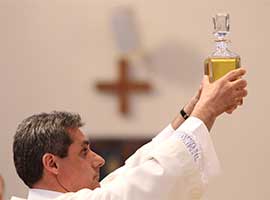The Roman Missal and the Chrism Mass
The text for Holy Thursday begins with a rubric formerly located at the beginning of the Evening Mass of the Lord's Supper prohibiting all Masses without a congregation on Holy Thursday (Roman Missal, rubrics for Holy Thursday, Chrism Mass [CM], no. 1). The General Instruction of the Roman Missal seems to encourage priests to concelebrate at both the Chrism Mass and the Mass of the Lord's Supper when it says in paragraph 204: "a Priest who has celebrated or concelebrated the Chrism Mass on Thursday of Holy Week may also celebrate or concelebrate the Evening Mass of the Lord’s Supper."
 Two new rubrics are inserted indicating that the blessing of the Oil of the Sick and the Oil of the Catechumens and the consecration of the Chrism are done according to the Order of Blessing the Oil of Catechumens and of the Sick and of Consecrating the Chrism (CM, no. 2). While the rubrics indicate that this Mass is usually celebrated in the morning of Thursday of Holy Week, indication is given that if it is difficult for the clergy and people to gather then the Chrism Mass may be anticipated on another day near Easter (CM, no. 3). These rubrics also appear in no. 275 of the Ceremonial of Bishops.
Two new rubrics are inserted indicating that the blessing of the Oil of the Sick and the Oil of the Catechumens and the consecration of the Chrism are done according to the Order of Blessing the Oil of Catechumens and of the Sick and of Consecrating the Chrism (CM, no. 2). While the rubrics indicate that this Mass is usually celebrated in the morning of Thursday of Holy Week, indication is given that if it is difficult for the clergy and people to gather then the Chrism Mass may be anticipated on another day near Easter (CM, no. 3). These rubrics also appear in no. 275 of the Ceremonial of Bishops.
The time for the blessing of oils has also been addressed in a newly composed rubric indicating that the blessing of the Oil of the Sick may take place before the end of the Eucharistic prayer. This positioning goes back to the Gelasian and the Gregorian Sacramentaries. Within the Eucharistic Prayer, the greatest prayer of consecration, a new wave of blessing is poured forth on the oil to be used for the sick. The blessing of the Oil of Catechumens and the consecration of the Chrism takes place after Communion. For pastoral reasons, the entire rite of blessing may take place after the Liturgy of the Word (CM, no. 5).
After the reading of the Gospel, the Bishop is to give a homily. The editio typica tertia is more precise about this than the previous rubric. It indicates: "[...] taking his starting point from the text of the readings proclaimed in the Liturgy of the Word, he speaks to the people and to his Priests about priestly anointing, urging the Priests to be faithful in their office and calling on them to renew publicly their priestly promises." (CM, no.8). The Renewal of Priestly Promises remains.
Music for the Preface of the Priesthood of Christ and the Ministry of Priests is provided in place in the Missale Romanum.
Finally, a new rubric is provided that indicates "[t]he reception of the Holy Oils may take place in individual parishes either before the celebration of the Evening Mass of the Lord’s Supper or at another time that seems more appropriate" (CM, no. 15). Although the Order for the Reception of the Holy Oils is no longer in print, a link is provided here, since this can be a means of catechizing the faithful about the use and effects of the Holy Oils and Chrism in Christian life.
